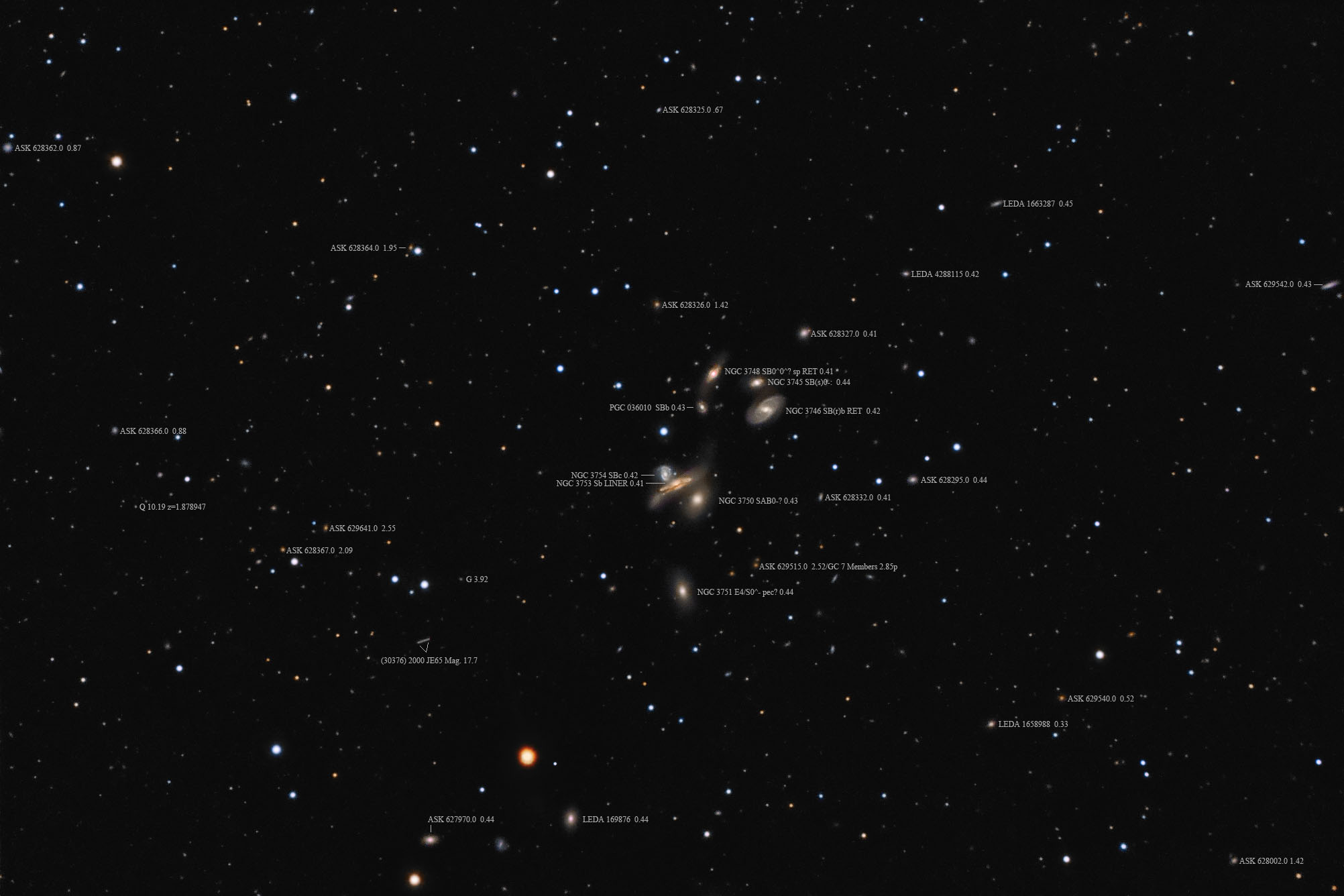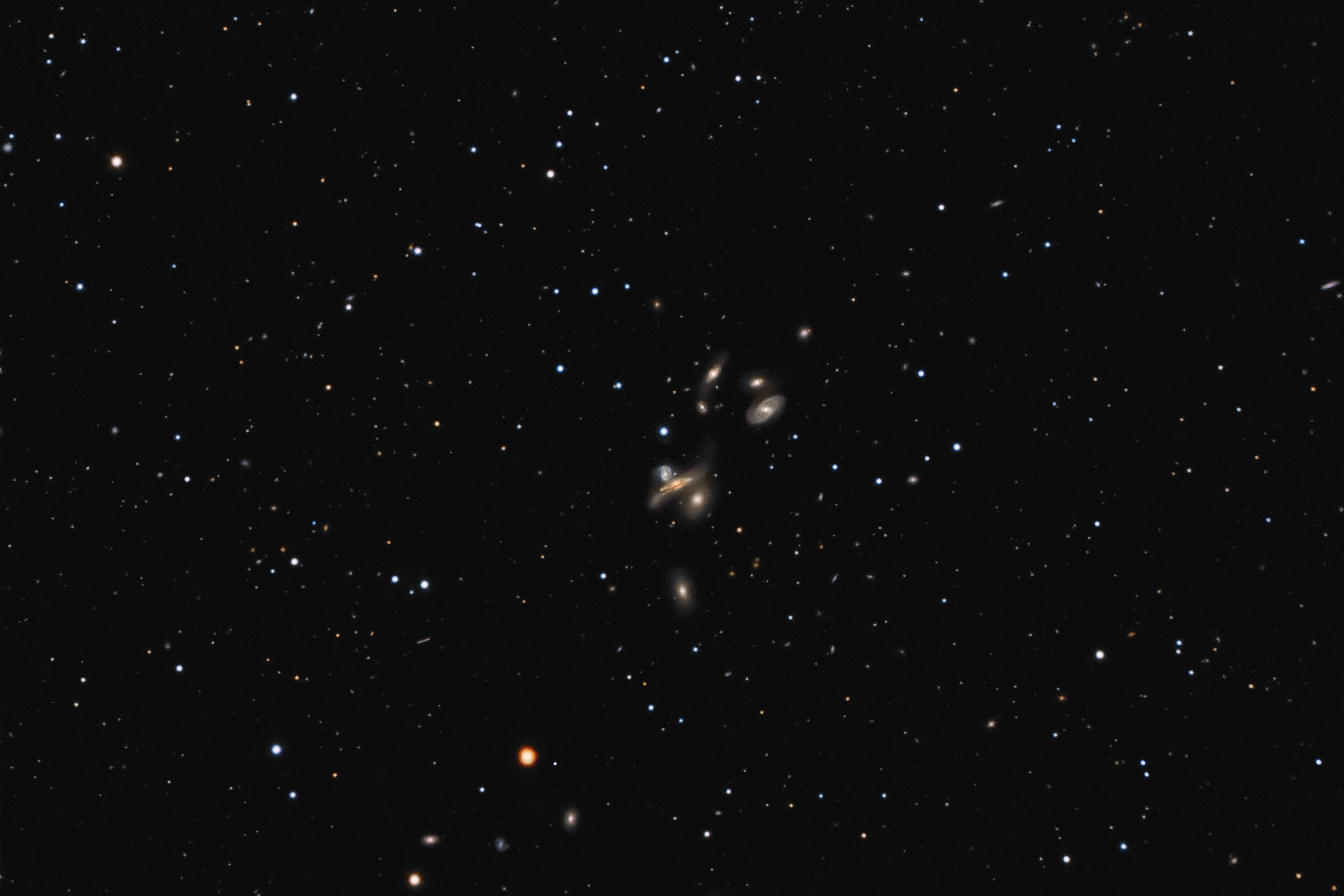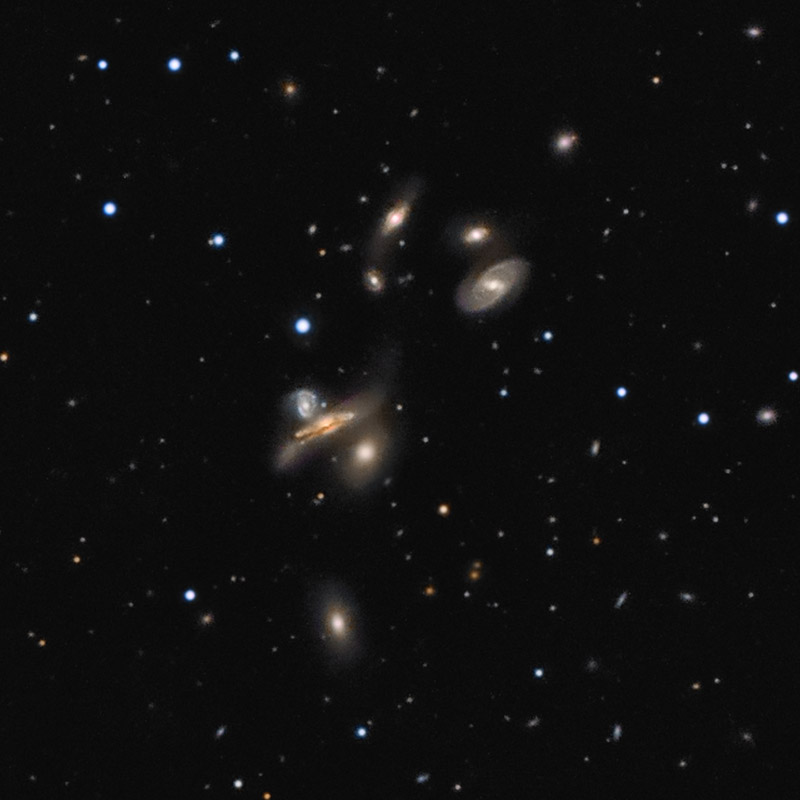| Description | Images |
Object name: ARP320Designation(s): ARP320, NGC3746, NGC3745, NGC3748, NGC3750, NGC3751, NGC3753, NGC3754, PGC036010, Arp 320/Copeland's Septet is a group of 7 galaxies though you'll see 9 main galaxies in the center of the field. A finder chart of the 7 that are members of the "official" septet http://www.ngcicproject.org/dss/n/3/n3753.jpg Related Designation(s):2MASS J11374363+2200353, 2MASS J11374445+2201167, 2MASS J11374907+2201343, 2MASS J11375051+2200451, 2MASS J11375165+2158272, 2MASS J11375380+2158520, 2MASS J11375387+2156113, 2MASS J11375492+2159080, 2MASX J11374364+2200349, 2MASX J11374443+2201170, 2MASX J11374903+2201340, 2MASX J11375047+2200450, 2MASX J11375378+2158520, 2MASX J11375386+2156110, 2MASXi J1137536+215850, 2MASXi J1137538+215611, 2MASXi J1137549+215908, 2XMM J113749.0+220133, 2XMM J113751.6+215827, 2XMM J113753.8+215849, 2XMM J113755.0+215908, ARP 320, ARP 320 NED01, ARP 320 NED02, ARP 320 NED03, ARP 320 NED04, ARP 320 NED05, ARP 320 NED06, ARP 320 NED07, ARP320, ASK 628328.0, ASK 628329.0, ASK 628330.0, ASK 628331.0, ASK 628333.0, CGCG 1135.1+2217, CGCG 1135.2+2218, CGCG 1135.3+2215, CGCG 1135.4+2216 NED01, CGCG 1135.4+2216 NED02, CGCG 127-006, CGCG 127-007, CGCG 127-009, CGCG 127-012 NED01, CGCG 127-012 NED02, CGCG 127-012N, CGCG 127-012S, Copeland Septet, Copeland Septet NED01, Copeland Septet NED02, Copeland Septet NED03, Copeland Septet NED04, Copeland Septet NED05, Copeland Septet NED06, Copeland Septet NED07, GALEXASC J113743.64+220035.9 , GALEXASC J113744.51+220118.9 , GALEXASC J113749.23+220133.5 , GALEXASC J113750.61+220045.3 , GALEXASC J113751.62+215826.3 , GALEXASC J113753.69+215612.9 , HCG 057, HCG 057A, HCG 057B, HCG 057C, HCG 057D, HCG 057E, HCG 057F, HCG 057G, HCG 057H, HDCE 0661 NED002, HDCE 0661 NED004, IRAS 11352+2216, IRAS F11352+2215, KUG 1135+222, LDCE 0826 NED002, LDCE 0826 NED004, MAPS-NGP O_376_2858137, MAPS-NGP O_376_2858854, MAPS-NGP O_376_2859071, MAPS-NGP O_376_2859431, MCG +04-28-004, MCG +04-28-005, MCG +04-28-007, MCG +04-28-008, MCG +04-28-009, MCG +04-28-010, MCG +04-28-011, NGC 3745, NGC 3746, NGC 3748, NGC 3750, NGC 3751, NGC 3753, NGC 3754, NGC3745, NGC3746, NGC3748, NGC3750, NGC3751, NGC3753, NGC3754, NPM1G +22.0340, NSA 112840, NSA 112841, NSA 112842, NSA 112843, NSA 112845, NSA 139936, NSA 139941, NSA 139944, NVSS J113754+215910, PCC N79-278, PGC 035997, PGC 036001, PGC 036007, PGC 036010, PGC 036011, PGC 036016, PGC 036017, PGC 036018, PGC036010, RSCG 43, SDSS J113743.62+220035.3, SDSS J113744.43+220116.5, SDSS J113744.43+220116.6, SDSS J113749.06+220134.1, SDSS J113750.49+220045.0, SDSS J113750.49+220045.1, SDSS J113751.63+215827.1, SDSS J113751.63+215827.2, SDSS J113753.79+215852.3, SDSS J113753.85+215611.3, SDSS J113754.91+215907.8, SDSS J113754.92+215907.7, SDSS J113754.92+215907.8, SPRC 203, SSTSL2 J113744.44+220116.6, SSTSL2 J113749.06+220134.2, SSTSL2 J113750.50+220045.2, SSTSL2 J113751.66+215827.3, SSTSL2 J113753.80+215851.4, SSTSL2 J113753.87+215611.2, SSTSL2 J113754.92+215908.0, UGC 06597, UGC 06601, UGC 06602, UGC 06602 NOTES01, UGC 06602 NOTES02, UGC 06602 NOTES03, USGC U404 NED01, USGC U404 NED02, USGC U404 NED04, USGC U404 NED05, USGC U404 NED06, UZC J113743.6+220035, UZC J113749.1+220134, UZC J113751.7+215827, UZC J113753.8+215852, UZC J113754.9+215908, UZC-CG 142 NED01, UZC-CG 142 NED02, UZC-CG 142 NED03, UZC-CG 142 NED04, VV 282a, VV 282b, VV 282c, WBL 343, WBL 343-001, WBL 343-002, WBL 343-003, WBL 343-005, X-CLASS 1937, [BDG98] J113743.6+220034, [BDG98] J113744.5+220116, [BDG98] J113749.1+220133, [BDG98] J113750.5+220045, [BDG98] J113751.7+215826, [BDG98] J113753.9+215610, [BDG98] J113753.9+215853, [BDG98] J113755.0+215908, [DZ2015] 666-01, [DZ2015] 666-02, [DZ2015] 666-04, [DZ2015] 667-01, [DZ2015] 667-03, [RLA2016] J174.4652+21.9742, [RPG97] 145, [TTL2012] 139607, [TTL2012] 139608, [TTL2012] 139609, [TTL2012] 139610, [TTL2012] 139612, [ZGH93] G021, |


